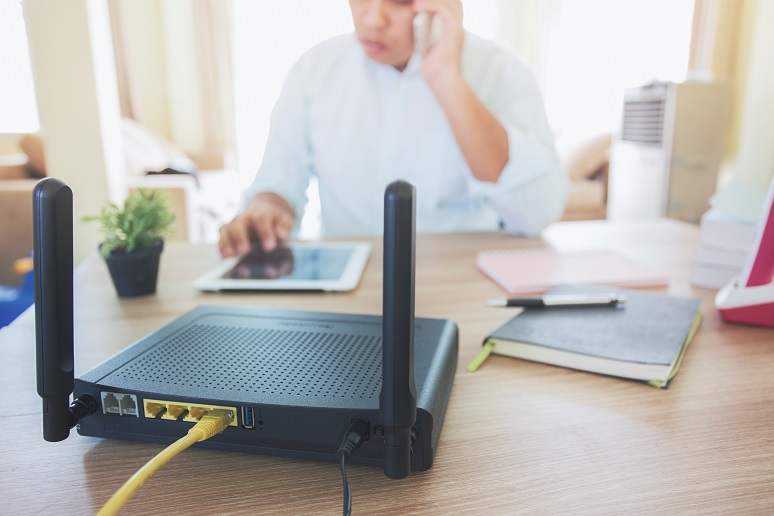Great wireless networking is complicated. In general, wireless will just work, even with poor implementations. However, a poorly designed implementation won’t work very well and may not meet the organization’s requirements. In a work-from-home world, the home wireless network can also contribute to poor application performance.
Wi-Fi within an Organization
First, find an experienced wireless design consultant to help with the task. Good wireless design is a highly specialized function, and it is well worth the expense to hire someone who has been doing it for a long time. This person should employ a thorough requirements analysis, design process, and on-site validation.
A critical element of the requirements analysis is identifying the least capable, most important (LCMI) device that must be supported. Old barcode scanners that are used within a warehouse might be a good example, while a school might have an older generation of tablets to support. You might find that a better long-term solution is upgrading old devices instead of forcing the network to handle them.
The next critical element is using the requirements to drive a preliminary design site survey. The wireless designer will incorporate the LCMI characteristics and a set of test devices to assess the environment. You don’t want to skip this step because it allows the designer to measure and consider unseen building structures that impact the resulting design.
A post-installation site survey can also validate equipment was properly installed and that the network meets requirements. For example, you don’t want to find access points (APs) designed for a ceiling mount to be mounted flat on a wall or APs mounted on metal building components.
Your network could have great Wi-Fi signal and still have horrible throughput due to co-channel interference. It is best to detect this condition through periodic site surveys. Wi-Fi is what I call a polite protocol. It listens to the channel first and only transmits when there is no other radio frequency (RF) activity. The RF environment changes over time as your organization’s requirements change and as environments change. Building occupants change their Wi-Fi implementations, microwave ovens get replaced, or metalized decorations might be installed. Of course, you may already know that the environment has changed if application performance over the wireless network changes. The site survey provides you the visibility into the RF environment that you need to make informed changes.
As you plan your next wireless equipment upgrade, look to move to 802.11ax (Wi-Fi6), which uses both the 5GHz and 2.4GHz channels. You should plan to eventually migrate to Wi-Fi6E that uses the 6GHz frequencies. But widespread support of Wi-Fi6E by modern endpoints is probably about three years in the future, giving you time to plan. When you upgrade devices, group all the new access points in specific areas. In other words, don’t spread them around using the salt-and-pepper approach. It doesn’t work well, and it increases the challenge of managing the network.
Work-From-Home Wi-Fi
The proliferation of work-from-home employees means that the IT organization may need to assist the home worker who has a poor Wi-Fi implementation.
Your IT organization may need to purchase remotely manageable Wi-Fi routers for installation at important homes. These routers would need to be monitored and should report on a range of operational parameters like excessive retransmissions, low-signal strength with clients, and large flows, which are typical of movie downloads or excessive streaming.
You should verify that the home uplink speeds, and the wireless router have comparable link capacity. Also, you shouldn’t connect a wireless router than can only handle 300Mbps to a 2Gbps uplink and expect to see more than about 300Mbps throughput in the speed tests. Similarly, check that the link speeds are the same or greater than what the router can handle. These may sound like silly things to check, but those details are frequently overlooked.
We even experienced the home Wi-Fi problem within our company. A non-technical employee continuously reported poor online meeting performance with choppy audio and video. He found poor throughput using speed test websites like
speedtest.net. When questioned about his installation, we discovered that his Wi-Fi router was some distance away from his home office desk. We had him run the speed test while sitting next to the wireless router. Unsurprisingly, he obtained over 300Mbps throughput, even with his daughter concurrently using the network for streaming. The solution was to install a Wi-Fi extender in his office. While such devices reduce overall throughput because of the relay function, they tend to improve performance over not using them.
The ultimate test — and frequently the optimum solution — is to install a wired connection between the router and the critical work-from-home endpoint. This can be a temporary cable just for testing (watch out for family members, including those with four legs). In cases where the applications use a lot of bandwidth or the RF environment is full of competing wireless signals, it may be necessary to replace wireless with a wired connection.
You should also consider using digital experience monitoring tools to monitor and diagnose problems in the work-from-home environment. These tools provide visibility into network infrastructure that you don’t manage as well as application-specific problems. This combination allows you to determine whether a slow application is due to a network problem or an application problem.
Summary
A lot of factors go into successful wireless networks, and my articles have touched on several of them. The critical element is to employ an experienced Wi-Fi design consultant who has the expertise and tools to do a great design and who can validate that the implementation meets the requirements.










